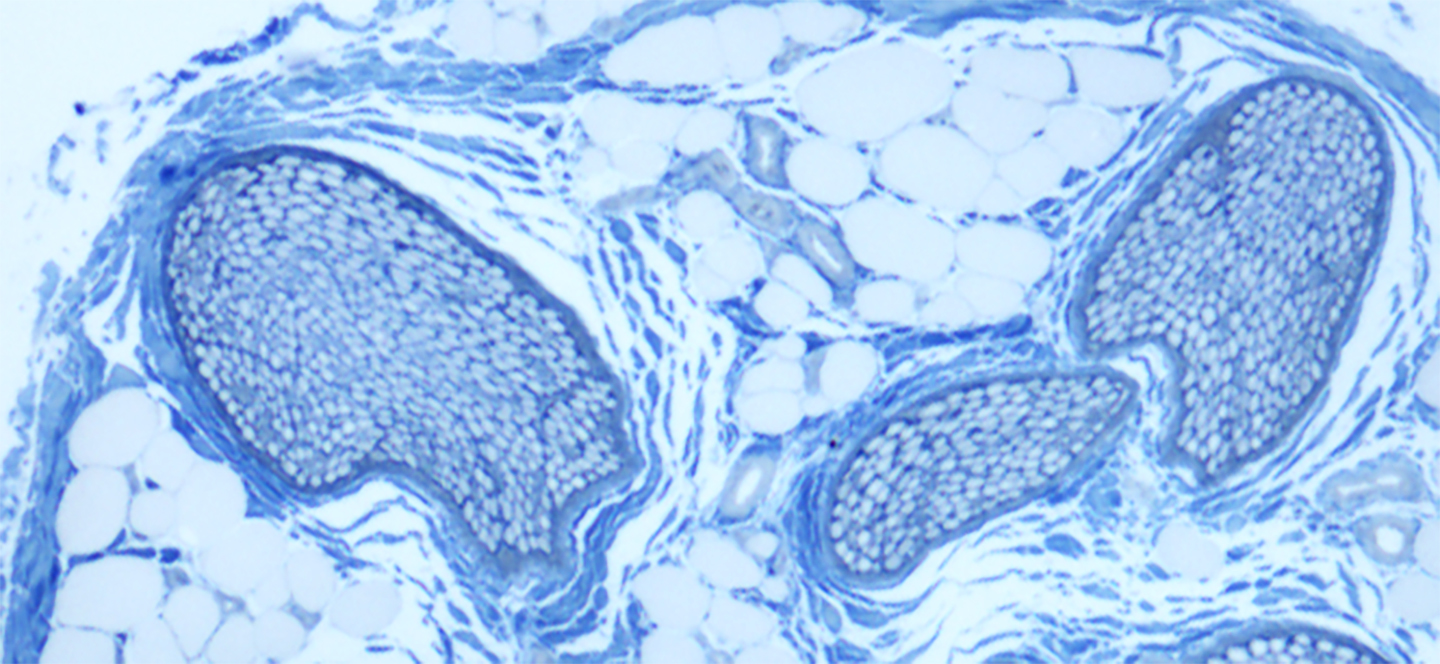PNS/CNS communication

Since many years, studies on peripheral nerve repair and regeneration represent one research focus at our institute. Peripheral nerve lesions result in impairment of quality of life with differing severity for patients, many suffer from life-long disabilities. Surgical techniques and therapeutic options have increased over the last decades, but achievable functional outcome of peripheral nerve repair is not always meeting patients expectations. In many years of research in peripheral nerve regeneration using animal models and in vitro systems, we contributed to the clinical approval of chitosan-based nerve guides and have worked on further improvement of these guides towards a replacement strategy for autologous nerve grafting. In our work, we combine material science approaches with tissue engineering attempts. The latter was originally based on genetic engineering of peripheral glia cells, Schwann cells, but has nowadays evolved to work with Schwann cells derived from human induced pluripotent stem cells (iPSCs). Such cells may represent a valuable source for upgrading otherwise cell-free or even hollow nerve guides able to support nerve repair also across large defect distances. Since the healthy and the injured peripheral nervous system communicate with the central nervous system, synaptic plasticity at the spinal cord level is an evolving field of research. Indeed, even if functionality in terms of motor function and touch sensation has been recovered to a considerable degree with successful peripheral nerve repair, patients may secondarily develop neuropathic pain. Furthermore full limb replantation approaches after amputation events, will need to consider not only conditions of the peripheral nerves inside the limb but also how the communication between the limb and the central nervous system can be recovered in a way that reduces motor impairment and limits the risk to develop neuropathic pain.
In this research focus we address questions related to peripheral nerve development and regeneration under different systemic conditions, and will enlarge our previous focus toward better understanding of the neuroanatomical basis of local pain perception and the development of neuropathic pain.
Specifically, the following points will be addressed:
- We study the “gut-peripheral nerve axis” using germ-free and gnotobiotic mice in healthy conditions and after peripheral nerve lesion. The gut microbiome and the metabolites derived from it are more and more understood to contribute to healthy or pathological conditions also of the nervous system via the “gut-brain-axis”. We perform functional, histological and molecular studies on various structures of the peripheral and the central nervous system. In this project we collaborate with the Gnotobiotic Group at the MHH-Institute for Laboratory Animal Science (Dr. Marijana Basic, Dr. Silvia Bolsega) and colleagues from Italy (Prof. Giulia Ronchi, University of Turin, Prof. Matilde Cescon, University of Padua).
- The conditions of peripheral nerves in an amputated limb of adult pigs are studied with functional, histological and molecular techniques. The aim of the project is to optimally condition peripheral nerves in amputated limbs under ex-vivo perfusion conditions for successful limb replantation (https://www.mhh.de/presse-news/hoffnung-fuer-schwerverletzte-nach-amputation-von-gliedmassen)https://www.mhh.de/presse-news/hoffnung-fuer-schwerverletzte-nach-amputation-von-gliedmassen. The investigations are carried out in close collaboration with PD Dr. Bettina Wiegmann from the MHH-Department for Cardiothoracic, Transplantation and Vascular Surgery. The work is funded by a contract of the German Armed Forces (2022-2024).
- We have recently established a protocol for deriving human Schwann cells from human iPSCs and plan to characterize them further with regard to their functional ability in vitro and in vivo towards a patient-specific application in peripheral nerve repair.
Key publications:
Gut microbiota depletion delays somatic peripheral nerve development and impairs neuromuscular junction maturation. Cescon, M.*, Gambarotta, G.*, Calabrò, S., Cicconetti, C., Anselmi, F., Kankowski, S., Lang, L., Basic, M., Bleich, A., Bolsega, S., Steglich, M., Oliviero, S., Raimondo, S., Bizzotto, D., Haastert-Talini, K.* and Ronchi, G.* Gut Microbes 2024, VOL. 16, NO. 1, 2363015. *authors contributed equally doi:10.1080/19490976.2024.2363015
Culture Conditions for Human Induced Pluripotent Stem Cell-Derived Schwann Cells: A Two-Centre Study. Huang, Z.*, Powell, R*, Kankowski, S., Philips, J.B., Haastert-Talini, K. Int. J. Mol. Sci. 2023, 24(6), 5366; doi: 10.3390/ijms24065366
In Vivo and In Vitro Evaluation of a Novel Hyaluronic Acid–Laminin Hydrogel as Luminal Filler and Carrier System for Genetically Engineered Schwann Cells in Critical Gap Length Tubular Peripheral Nerve Graft in Rats. Dietzmeyer N., Huang Z., Schüning T., Rochkind S., Almog M., Nevo Z., Lieke T., Kankowski S., Haastert-Talini K. (2020) Cell Transp, 2020, Volume 29: 1–20. doi: 10.1177/0963689720910095
Chitosan-film enhanced chitosan nerve guides for long-distance regeneration of peripheral nerves. Meyer, C.*, Stenberg, L.*, Gonzalez-Perez, F.*, Wrobel, S., Ronchi, G., Udina, E., Suganuma, S., Geuna, S., Navarro, X., Dahlin, L.B., Grothe, C.*, Haastert-Talini, K.* Biomaterials. 2016; 76:33-51. doi: 10.1016/j.biomaterials.2015.10.040